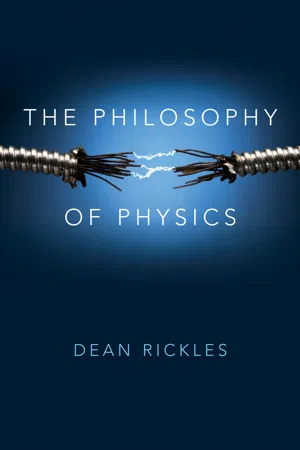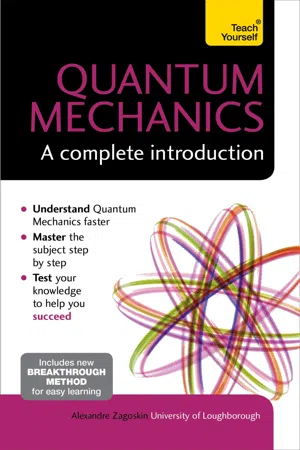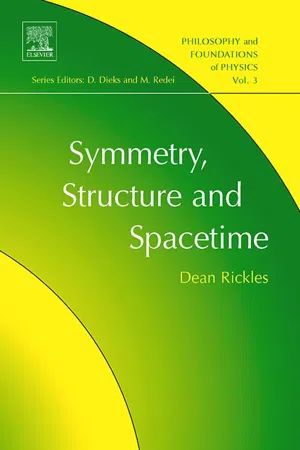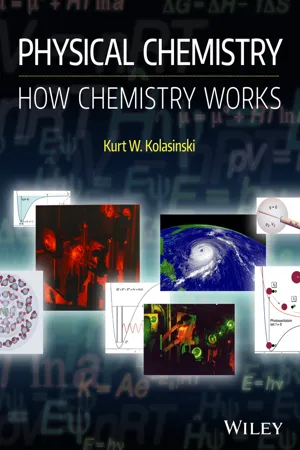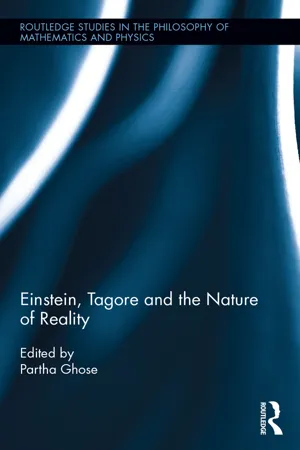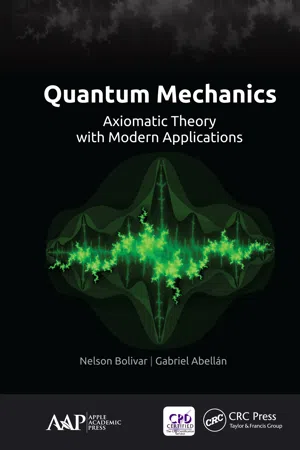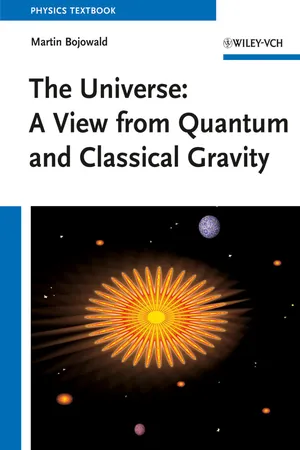Physics
Observables
Observables in physics are measurable properties of a system, such as position, momentum, energy, or spin. They are represented by mathematical operators and play a crucial role in quantum mechanics, where they provide information about the state of a physical system. Observables are used to make predictions about the outcomes of measurements in quantum theory.
Written by Perlego with AI-assistance
Related key terms
Related key terms
1 of 4
Related key terms
1 of 3
9 Key excerpts on "Observables"
- eBook - ePub
- Dean Rickles(Author)
- 2016(Publication Date)
- Polity(Publisher)
dual role: on the one hand they are measurable quantities, allowing us to latch the theory onto the world, providing information about a state of the world. On the other hand they generate specific transitions of the state of a system from one to another: for example, the energy observable (aka the Hamiltonian function), when viewed in phase space terms, generates time-translations.)Fig. 2.3 Representation of an observable in classical physics, mediating between an abstract state space and some numerical value that is associated with an experimental outcome n ∊ .The Observables in the classical case are functions from the phase space to (real) numbers: this is the link between the abstract representation, given by the state space, and reality, as given in measurements that can be associated with real number values. Take as an extremely simple example (a standard case study for physics introductions): a coin. This is a two-state system, and so it has a state space with just two points: Heads and Tails. An observable would have to be a function on this space, so that it spits out some numerical value depending on what state it is fed. We can write (Heads) = 1 and (Tails) = 0 – now we have made this association, if we want to be formal we can write the state space as = {0, 1}. Far more complicated examples occur in physics, such as energy Observables that spit out a number representing the total energy of a system (that can deliver a continuum of possible values, rather than {0, 1}) when fed a point from the phase space. But still, this simple setup gets the basic point: classical Observables are functions from the state space to numbers: : → (see fig. 2.3 - Alexandre Zagoskin(Author)
- 2015(Publication Date)
- Teach Yourself(Publisher)
5 Observing the ObservablesIn Chapter 2 we discussed observation and measurement. We called the physical quantities, which characterize a quantum system, Observables. We have stated that they are operators, i.e. subtler and more sophisticated mathematical entities than just numbers and vectors, with which we were satisfied in classical physics. We have introduced their eigenvalues and their expectation values in a given quantum state, that is, what we expect to observe respectively, in a single measurement or on average after many repeated measurements.Measurement, projection postulate and Born’s rule (revisited)All this sounded very natural. Science begins with observation and measurement. But in quantum mechanics these two words acquire a special importance and must be used with precision. Here they both mean the same, namely that measurement (or observation) is a special kind of interaction of a quantum system with another system called a measuring device, or apparatus. The apparatus is supposed to obey the laws of classical physics.The result of a measurement is that the state vector of the quantum system is projected on one of eigenvectors of one of the Observables Â, which characterize the system. (Which observable it will be depends on the apparatus.) At the same time, the apparatus will evolve from its initial state to some final classical state, which is determined by which eigenvector the quantum state was projected to (Figure 5.1 ). This is called the measurement of the observable Â.Figure 5.1 Measurement, state vector projection and change in the classical apparatusOne should keep in mind that the observation and measurement in quantum mechanics do not- eBook - ePub
- Dean Rickles(Author)
- 2007(Publication Date)
- Elsevier Science(Publisher)
∞ ones) comprise the gauge freedom in the theory. The diffeomorphisms underlie the general covariance of general relativity, and this tells us that the models that are thus related will be indistinguishable as far as quantities not connected to the pointwise location of the fields are concerned. Therefore, the hole argument fails to get a grip: general relativity isn’t meant to predict values for these quantities, nor for any quantities localized to points of the (bare) manifold regardless of how well we can specify them in connected regions of spacetime. The kinds of quantity that do class as Observables in general relativity are relational (or highly non-local), much as Einstein argued, though not quite so narrowly defined. (I agree with this classification, but below I tame the view of many physicists that this implies relationalism about spacetime.) Let us say a little more about these Observables, and give some examples that connect with measurements.6.1 DEFINING Observables
It is Observables that give us our connection to the world in the context of physics; they are the things we measure and whose values we predict. They form the qualitative character of a world in the sense that two worlds that are duplicates in terms of the Observables they contain, and in terms of their assigned values, are qualitatively indistinguishable. I think that the resolution of the hole argument can only come about once we have a proper grasp on what the theory of general relativity is about and what it is supposed to predict. This might sound rather obvious, but this involves the problem of defining the Observables of general relativity— a notorious problem that I discuss more fully in the next chapter. In this section I simply skirt over many ‘deep’ issues, and highlight the relevance of the definition of Observables to the hole problem (including a natural resolution) and, in a preliminary way, to the problem of time.In general relativity, the physically relevant quantities are taken to be the diffeomorphism invariant quantities, or Bergmann Observables. These are any quantities that spit out the same values under ‘draggings’ of the dynamical fields (the building blocks of the Observables) by diffeomorphisms. If we accept the view that general relativity is a gauge theory, with the gauge part given by the diffeomorphisms, then the Observables will be gauge invariant quantities, or Dirac Observables. This is usually taken to mean that any quantities that are related by a gauge-transformation describe the same physical state; one and the same physical possibility is being multiply represented, and the excess representational machinery is deemed to be mere surplus structure. But this is not necessary. As far as the physics goes, I think that such differences should not make a difference; the Observables grasp on to the qualitative character of the world, and any quantities that fail to distinguish between qualitative duplicates should be ruled out on the grounds that they would not be measurable or predictable in the context of the theory. This, I submit, is what is desired from gauge invariance; when physicists say physical equivalence, they simply mean to imply qualitative, or empirical equivalence. Gauge invariance of the Observables then implies that those differences that are non-qualitative do not get counted in, say, statistical algorithms or in the initial-value problem of the theory (or it does so only ‘up to a gauge transformation’). But this does not imply that there are not such differences, or that the ontological elements that are allowing for the qualitatively indistinguishable worlds (e.g. the manifold and its symmetries) do not exist. This cannot be read off the physics, but the Observables don’t care about such things.192 These quantities, as we have seen, avoid the hole argument, for that argument only targeted those quantities that were changed by a diffeomorphism, quantities localized at points of the spacetime manifold (e.g. the scalar curvature at the pointxi∈ - eBook - ePub
Physical Chemistry
How Chemistry Works
- Kurt W. Kolasinski(Author)
- 2016(Publication Date)
- Wiley(Publisher)
CHAPTER 20 The quantum mechanical description of naturePREVIEW OF IMPORTANT CONCEPTS
- We can expect to observe quantum mechanical effects and the insufficiency of a classical mechanical description when at least one dimension of the system under consideration approaches the magnitude of its de Broglie wavelength.
- A quantum mechanical description should be used when the thermal energy kB T is small compared to the energy level spacing ϵi− ϵj.
- In the limit of high quantum numbers, systems behave classically. Equivalently, in the limit of large energies, large masses and large orbits, quantum calculations deliver the same results as classical calculations.
- The postulates of quantum mechanics cannot be derived from more fundamental principles and form the basis of the theory from which its framework is derived.
- The wavefunction describes everything there is to know about a system.
- The absolute square of the wavefunction describes a probability distribution.
- Operators act on wavefunctions to determine the values of Observables.
- If a system is in an eigenstate of an operator, the corresponding observable has an exact value. If the system is not in an eigenstate of the operator, the observable is described by an expectation value that is equal to the mean of many measurements.
- The eigenstates of a system form an orthonormal basis set.
- Eigenstates can be superposed in linear combinations to create states of the system. Wavefunctions have relative phases, which can lead to interference effects when they are combined.
- eBook - ePub
- Partha Ghose(Author)
- 2016(Publication Date)
- Routledge(Publisher)
7 Physical reality and the unObservables of physical nature C. S. Unnikrishnan Introduction and scope The fundamental physical theories that interpret and explain the behaviour of matter in nature are dependent on several unObservables and insensibles in their construction. Entities like fields, wave functions and even space and time are all unObservables, except as manifestations of material existence and behaviour. There is thus an obvious difference of degree and meaning between the reality associated with these unobservable theoretical entities and that of perceptible matter. The success of the physical theory is often taken as evidence for the physical reality of such unObservables. While a rigorous natural philosophy will not be able to support or approve their reality with the same vigour and conviction as it might defend the reality of matter, there does not seem to be a way of avoiding such unObservables if we have to construct theories. Though there is compatibility and consistency between Observables and unObservables in most of classical physics, apparent conflicts and dissonance arise when microscopic physics is to be understood with a satisfactory theory. There are even observational consequences highlighting such conflicts when cosmology and the dynamics of the universe are included into the larger physical framework. In this chapter, I examine the nature of physical reality in the context of unavoidable unObservables in physics 1, 2 and discuss some examples. For the purpose of this discussion, I will work with a definition of an unobservable (in physics) as a quantitative entity, created and mathematically representable in relation to a theory of sensible matter and its behaviour, but whose ontological status cannot be established nor demonstrated directly or by deduction employing methods usually used for material entities - eBook - ePub
Quantum Mechanics
Axiomatic Theory with Modern Applications
- Nelson Bolivar, Gabriel Abellán(Authors)
- 2018(Publication Date)
- Apple Academic Press(Publisher)
p ) . As we said, a physicalquantity is represented by a function of q andand the value of the function at a given time is the result of a possible measure. Therefore, the measurement of a given size in a given system is always a unique result.p : A = A ( q , p , t )In quantum mechanics, the situation is fundamentally different, because the coordinates q and p are not compatible they are not enough to determine the state of the system. A state of the system, which we call a quantum state, will be determined from the knowledge of a set maximum of certain quantities that are independent and compatible with each other.A measurable physical quantity is called an observable. If at a given moment a measurement is performed by one or more compatible Observables it is said they are performing an observation of the system.A briefly remark is an independent set of maximum and compatible Observables. For example, the Lagrangian coordinates q 1 , qNand the conjugate momenta p 1 , pNconstitute two different maximum observations of a system. This shows us that a generic maximum observation consists of General set of N variables, while in classical mechanics this number is 2N .Therefore, let it be A 1 , A 2 , .. ANa “maximum set of Observables” of a system and a = a 1 , a 2 , ...aNthe observed values of these. The corresponding quantum state will be labeled with the symbol, notation introduced by Dirac. If the system is in the Stateaand a measurement Aaiis performed, one of aiwill result and is unique. In this case we will say thatis an eigenstate of Aai.Every observable admits at least one eigenstate to every possible result of a measurement. Conversely, a givenof the system, if a measurement of an observable B incompatible with Aa - eBook - ePub
The Universe
A View from Classical and Quantum Gravity
- Martin Bojowald(Author)
- 2012(Publication Date)
- Wiley-VCH(Publisher)
n it takes. The probability of finding the same result in a second measurement right afterwards, leaving no time for further emission or absorption processes, must result in the same value, with certainty because we already know what the energy is. The wave function contains all information about the system, in a statistical way because our knowledge is never complete. However, if an observable has already been measured, we know its value right after the measurement, without qualifying statistics. After measuring an observable, the state must be one that fully belongs to the observable, or an eigenstate with the eigenvalue measured.Energy eigenstates are nothing but stationary states. The new terminology is useful because it applies to any observable O. If we know the operator Ô, we can compute eigenvalues and eigenstates by the equation ÔΨn= OnΨn. In analogy with energy eigenstates, we say that a system takes on an eigenstate Ψnof Ô if the observable Ô has been measured with value On. For momentum, for instance, we have the operator = −i Δ/Δx, and eigenstates are Ψk(x) = exp(i k x) with eigenvalues pk= k. As in this case, eigenvalues do not always form a discrete set.We know what states we can have after measuring an observable, and what measurement results are possible. The last piece, the actual value that we will measure, remains statistical. If the state is not an eigenstate to begin with, after a measurement different eigenstates can be reached with some probabilities. The usual statistical properties of the wave function appear: A general state can be written as Ψ (x, t) = SumnCnΨn(x, t) in terms of eigenstates Ψnof the observable we measure, with complex numbers Cnthat tell us how each eigenstate contributes. After the measurement, we find one state Ψn, and the probability by which it appears is |Cn|2 .Collapse of the wave function - Volodymyr Krasnoholovets(Author)
- 2017(Publication Date)
- Apple Academic Press(Publisher)
Among them we can cite the notion of “wave-particle” duality (that is not apparent in classical and high energy physics); the probabilistic interpretation of the Schrödinger wave ψ -function and hence the probability amplitude and its phase; long-range action of the quantum mechanical interaction; Heisenberg’s uncertainty principle; the passage to the so-called operators of physical values, etc. For example, Quantum Mechanics by Landau and Lifshitz [ 105 ] begins with the words that in quantum mechanics all physical values are described by operators. So from the very beginning any physical description and physical interpretation of the processes examined by the formalism of quantum mechanics are rejected; only a set of initial and final energy states of the particle under consideration are the subject of study. Modern views on an interpretation of quantum mechanics are reduced to a set of statements that allow one to explain the result of a measurement by avoiding the intrusion of the observer into the process of that measurement- eBook - ePub
- David Bohm(Author)
- 2012(Publication Date)
- Dover Publications(Publisher)
(3) The interrelationship between parts of a system can be described with the aid of exact causal laws that define the changes of the above dynamical variables with time in terms of their initial values. The behavior of the system as a whole can be regarded as the result of the interaction of all of its parts.It is characteristic of the classical domain that within it exist objects, phenomena, and events that are distinct and well-defined and that exhibit reliable and reproducible properties with the aid of which they can be identified and compared (see, for example, Chap. 8 , Secs. 17 to 22). It is this aspect of the world that is most readily described in terms of our customary scientific language, in which the ideal is to express every concept in terms of well-defined elements with well-defined logical relationships between them.When we come to describe quantum concepts, however, we find that just because our customary scientific language aims for such precision, it leads to difficult and unwieldy modes of expression. For as we have seen,* the quantum properties of matter are to be associated with incompletely defined potentialities, which can be more definitely realized only in interaction with a classically describable system (a special case of which is a measuring apparatus.)† Because even the so-called “intrinsic” properties of a system (e.g., wave or particle) are brought out only in interactions with other systems, it is clear that the quantum properties of matter imply the indivisible unity of all interacting systems. Thus, we have contradicted assumptions (1) and (2) of the classical theory, since there exist at the quantum level neither well-defined elements nor well-defined dynamical variables, which describe the behavior of these elements. It is not surprising, then, that assumption (3) is also not satisfied in the quantum theory, since exact causal laws would be meaningless in a context in which there were no precisely defined variables to which they could apply. In fact, instead of having well-defined variables that are in a one-to-one correspondence with the actual behavior of matter, we have at the quantum level a wave function that is only in statistical correspondence with this behavior.‡
Index pages curate the most relevant extracts from our library of academic textbooks. They’ve been created using an in-house natural language model (NLM), each adding context and meaning to key research topics.
Explore more topic indexes
Explore more topic indexes
1 of 6
Explore more topic indexes
1 of 4
